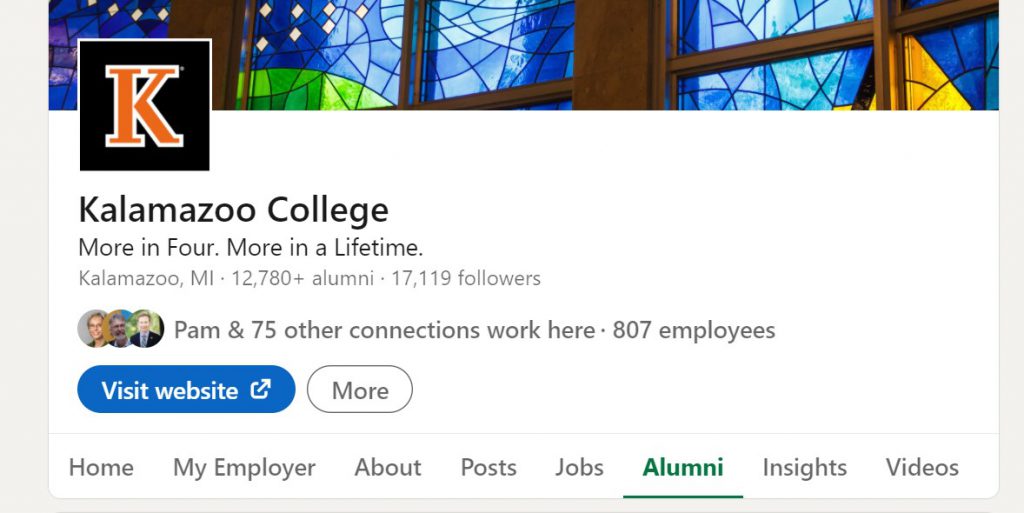Here’s a common refrain in my coaching practice:
Me: “Do you have a LinkedIn profile?”
Student: “I have one, but I’m not doing anything with it. It’s blank.”
Me: “I get this a lot. Here’s what you can do with a free profile that will actually help you get an internship. You might be surprised, but it has virtually nothing to do with searching jobs posted…”
Almost 95% of recruiters use LinkedIn to search for candidates, but the majority of our students have a basic profile with the title of “student”. They created it, probably because someone told them they should, and maybe they have added their roommates or a few friends.
But there’s so much more you can do with this platform to advance your career.
Take charge of your future and attract more attention from potential employers. Try these tips for designing and using your LinkedIn profile.
Designing your LinkedIn Profile:
1. Edit your headline. Start by writing a specific headline. Tell employers what value you add and make them want to learn more. Keep your audience in mind and avoid technical terms that may be unfamiliar to them. You have 230 characters here. Examples might be “Aspiring policy-maker looking to gain experience on the ground in the nonprofit sector”, or, “Creative programmer seeking opportunities to utilize data analytics skills”
2. Update your summary. Your summary is where you can add more details and showcase your achievements. Provide statistics to describe your impact. Add multimedia attachments like videos and work samples to help you stand out.
3. Choose your photo. Pick an image that looks professional and clear. Focus on your face and use flattering natural light. Consider your background photo—do you see others in your industries of interest with creative backgrounds? What makes sense for you?
4. Add keywords. Help recruiters and automated search tools to find you. Browse through job descriptions and resumes for keywords that are popular in your field and include them in your profile, including the headline and summary.
5. Choose your URL. LinkedIn gives your profile a URL, but you can change it to something that you like better or might work more effectively for you. If your name is already taken, use a slight variation with your middle initial, a hyphen, or an underscore.
6. Welcome recruiters. Is your profile visible to recruiters? Go into your privacy settings to be sure that you’ve opted to let them know that you want to hear from them. You’ll need to reset this switch every few months if you’re still looking.
7. Be consistent. Your resume is usually written for a specific opening while your profile is a more general statement. Still, you want them to be similar enough to avoid causing any confusion. If you are searching for multiple types of roles, talk with a career professional about how to make a headline/summary that keeps you open.
8. Check the meter. LinkedIn provides a profile strength meter to help you rate yourself. It will give you helpful recommendations about additional steps you can take, such as adding more information about volunteer work and foreign languages.
Actively Using Your LinkedIn Profile:
1. Find Kalamazoo College alumni doing things you find interesting. Check out their (often circuitous) career paths. How might you get where they are now? What skills do they have? Check out this >2 minute video on how to use the Alumni Tool.
2. Gather recommendations and endorsements. Recruiters want to know what others say about you. Ask former classmates, professors, employers and other contacts for recommendations. Use your endorsements to advertise skills that are in high demand. Not sure how to ask for a recommendation? Write one for someone else! If you’re generous about helping others, they’ll be more likely to return the favor.
3. Write and publish. Share your knowledge and insights on the LinkedIn publishing platform. You are already writing for your classes, why not share that writing publiclly?
4. Follow companies of interest. Like/comment on their posts.
5. Join groups. Look for groups in your subject area and participate actively. Post articles and answer questions.
6. Monitor your connections. Stay on the lookout for valuable connections to add to your network. Send them personal invitations that will make a positive impression. Did someone recently give you a business card? Add them that evening! Did you meet an alum at an event on campus? Reach out!
7. Encourage others. Think of LinkedIn as a community where you can exchange ideas and support. Comment on posts from other users and share them with your own connections.
Your LinkedIn profile is much more than just an online resume. Utilize it to maintain and develop your network— without ever having to change out of sweatpants!

